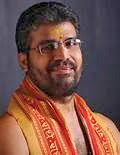The Process of Yoga : 2.4 - Swami Krishnananda.
=============================================================
==============================================================
Saturday, April 09, 2022. 06:00.
Chapter 2: The Structure of the Universe-4.
=============================================================
Now, what is the process of inferring the existence of something prior to the manifestation of the five elements? It is the same principle of logic – philologistic deduction. We have philologistic logic: All men are mortal, Socrates was a man, and therefore Socrates was mortal. There are two kinds of philologistic deduction. One is proper and the other is improper. The proper philologistic deduction is that all men are mortal, Socrates is a man, and therefore Socrates is mortal. Quite agreeable. But an improper deduction is something like this: Queen Victoria is a woman, my mother is a woman, and therefore my mother is Queen Victoria. This is an improper deduction; it is not correct. Just because both are women, it does not mean both are Queen Victoria. So there can be wrong logic and wrong inference that apparently looks all right. Due to such deductions as these, we have many philosophies in the world. They look all right, but they are not really all right.
You have to listen to me carefully. The world of perception is in the position of objects. And we have concluded that objects are known to exist either due to perception or due to an inferential deduction. If an object is to exist, it must be proved by certain methods of logical deduction. These proofs cannot emanate from the objects themselves. The Earth does not prove its existence either by perception or through inference, and so on. Some other element, some other principle is necessary to bring forth this proof of the existence of something. Whether it is perception or inference, it is an operation of consciousness. It is somebody who is conscious, somebody who is intelligent – someone who is aware, so to say – who concludes perceptionally or inferentially that an object exists. Here we are not concerned with the simple object of normal perception; we are thinking of larger objects, like the five elements – or we may say that there is only one object, the whole world of five elements. This large object in the form of the five elements is known to exist by a consciousness. Whether this consciousness knows it perceptionally or inferentially is a different matter. It goes without saying that a consciousness seems to be the principle behind the conclusion that the world as a huge object does exist. So we have on the one side the world of objects, and on the other side consciousness. We have a twofold procedure of deduction. One is a deduction of the principle of consciousness, and the other is a deduction of the principle of objects. We cannot escape this twofold principle.
This is why, in India at least, there is a school of thought called the Samkhya, which concluded that there are two realities, the object and the subject. The Samkhya calls it prakriti on one side and purusha on the other side. Purusha is the principle of consciousness, and prakriti is the principle of objectivity. The world of objects is prakriti, and the principle of consciousness is purusha. The whole universe is nothing but prakriti and purusha. There are only two things everywhere – something that is known and something that knows, something that is seen, perceived or inferred and another thing that sees, perceives or infers. This is the Samkhya philosophy, the Samkhya doctrine of the duality of the object and the subject. We cannot conceive of anything else anywhere. Whatever is there is something that is seen. But something that is seen is, after all, seen by something else. That something else is the element of consciousness. So we come to a dual experience of the large world of objects, the universe before us, and we ourselves as observers thereof of consciousness and matter, purusha and prakriti, the seer and the seen. This is the universe of experience.
But the problem does not end here. We are carried forward by an inferential demand of a necessity to bring about a coordination between purusha and prakriti. We cannot have a large gulf between purusha and prakriti and be happy. The gulf has to be bridged. A yawning gulf without a bridge between the two terms of relation is indefensible, logically. A gulf cannot be there unless we know that there are two shores containing the gulf. The very fact of the consciousness of difference is proof enough of there being a concordance or a harmony between the two terms of the relation apparently differentiated or separated by the so-called gulf. If the prakriti or the world of objects is to be there, and a purusha as a centre of consciousness also is to be there, we have to know what the relation between the two is. The whole of life is nothing but this supreme relation between purusha and prakriti. Yesterday we were trying to discuss the nature of life and the purpose of life, the spirit of life and the nature of spirituality. This question has brought us now to the other question, the relation between consciousness and matter, this relationship being nothing but life, or the spirit of life.
The relation between purusha and prakriti is a subject that is discussed in all the scriptures, especially the Bhagavadgita, the Upanishads and the Vedanta Shastras.
Prakṛitiṁ puruṣam caiva viddhyanadi ubhav api (13.19), says the Bhagavadgita.
two principles seem to be eternal. We cannot know when prakriti came into existence, and also we cannot know when consciousness came to exist. However much we may go behind and beyond the causal series of the evolution of prakriti, we seem to be there as an observer thereof, which is why we cannot say when prakriti came into existence; and we also cannot know when consciousness came into existence because however much we may go behind and behind and behind the principle of consciousness, there is a consciousness behind that principle of consciousness. Behind consciousness there is a consciousness of that consciousness, so we are caught up in a logical seesaw. The origin of creation cannot be proved logically because however far behind we go in the causal series, we seem to be there as an observer thereof.
To be continued ....
==============================================================
.png)





Comments